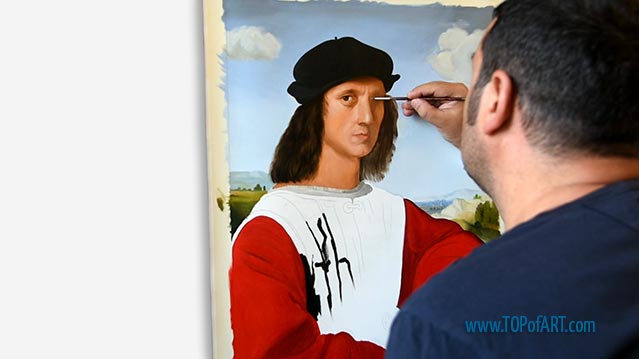The Dream of Saint Helena, c.1570 Paolo Cagliari Veronese (c.1528-1588)
Location: National Gallery London UKOriginal Size: 197.5 x 115.6 cm
Own a museum-quality reproduction of The Dream of Saint Helena by Veronese (c.1570), exclusively hand-painted in oils on linen canvas by European artists with academic training. Each masterpiece is created with meticulous craftsmanship, capturing the exceptional quality and authentic brushwork of the original painting.
Oil Painting Reproduction
If you want a different size than the offered
Description
Painted by European Аrtists with Academic Education
Museum Quality
+ 4 cm (1.6") Margins for Stretching
Creation Time: 8-9 Weeks
Creation Process
We create our paintings with museum quality and covering the highest academic standards. Once we get your order, it will be entirely hand-painted with oil on canvas. All the materials we use are the highest level, being totally artist graded painting materials and linen canvas.
We will add 1.6" (4 cm) additional blank canvas all over the painting for stretching.
High quality and detailing in every inch are time consuming. The reproduction of Paolo Cagliari Veronese also needs time to dry in order to be completely ready for shipping, as this is crucial to not be damaged during transportation.
Based on the size, level of detail and complexity we need 8-9 weeks to complete the process.
In case the delivery date needs to be extended in time, or we are overloaded with requests, there will be an email sent to you sharing the new timelines of production and delivery.
TOPofART wants to remind you to keep patient, in order to get you the highest quality, being our mission to fulfill your expectations.
We not stretch and frame our oil paintings due to several reasons:
Painting reproduction is a high quality expensive product, which we cannot risk to damage by sending it being stretched.
Also, there are postal restrictions, regarding the size of the shipment.
Additionally, due to the dimensions of the stretched canvas, the shipment price may exceed the price of the product itself.
You can stretch and frame your painting in your local frame-shop.
Delivery
Once the painting The Dream of Saint Helena is ready and dry, it will be shipped to your delivery address. The canvas will be rolled-up in a secure postal tube.
We offer free shipping as well as paid express transportation services.
After adding your artwork to the shopping cart, you will be able to check the delivery price using the Estimate Shipping and Tax tool.
Museum Quality
The paintings we create are only of museum quality. Our academy graduated artists will never allow a compromise in the quality and detail of the ordered painting. TOPofART do not work, and will never allow ourselves to work with low quality studios from the Far East. We are based in Europe, and quality is our highest priority.
Additional Information
The subject derives from the fourth-century legend of Helena, mother of Constantine, whose dream prompted the journey that led to the discovery and authentication of the Cross. Veronese compresses biography into a suspended instant: sleep as threshold between private reverie and public mandate. Her bodily abandon contrasts with the purposeful, if effortful, flight of the cherubs, suggesting revelation arriving unbidden, before resolve can be formed.
Colour is uncharacteristically restrained. Instead of the saturated, enamelled hues we associate with Veronese’s pageantry, we find a handful of earthen pinks, tawny ochres, and cool, now yellow-grey atmosphere—the latter the result of smalt’s deterioration from its original blue. The subdued gamut concentrates attention on the modulation of light: a pearly shimmer slides over Helena’s gown, catching broken ridges of paint so that fabric seems to breathe, as though light itself were the dream coursing through her limbs.
The brushwork is economical, even summary in passages. Veronese lays in broad planes, then flickers selective highlights along creases and hems; detail is withheld where narrative emphasis is unnecessary. The face, turned up and seen from below, is smoothly modelled yet not fussed; hands are indicated with brisk competence. This swift execution, married to optical vitality at a distance, argues for a functional site—likely elevated—where legibility depended on large tonal masses rather than minute finish.
Compositionally the canvas is a study in dramatic cropping. Helena fills the vertical format; architectural ledge and bench establish a triangle that locks her in place while propelling the eye upward along her tilted head toward the airborne Cross. The voided sky, stripped of landscape distraction, becomes a stage for apparition. The vantage from below—underside of chin visible, horizon suppressed—supports the theory that the work served as an organ shutter to be seen from the nave floor when closed.
The design ultimately traces back to an anonymous print after a drawing attributed to Raphael (once even read as Danaë). Veronese appropriates the pose yet amplifies immediacy through enlargement and truncation; both a putto’s foot and Helena’s lower extremity are clipped, evidence that the canvas was trimmed. The knotty tangle of Cross and cherubs introduces a distinctly Venetian dramatic accent absent in the graphic source.
Liturgical function, Franciscan devotion to the True Cross, and the pairing custom of organ wings make a companion image of Constantine plausible. A later chapter may place this canvas in Rubens’s celebrated collection, a testimony to its afterlife among connoisseurs attuned to painterly daring. What endures is the paradox it stages: revelation communicated through palpable material economy—pigment, linen, light—translating theology into the language of flesh and sleep.
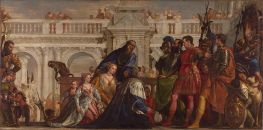
The Family of Darius before Alexander c.1565/67
$9349
$61.76
Paolo Cagliari Veronese
Original Size:236.2 x 475 cm
National Gallery, London, UK
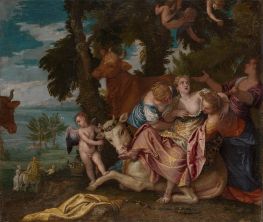
The Rape of Europa c.1570
$6202
$78.97
Paolo Cagliari Veronese
Original Size:59.5 x 70 cm
National Gallery, London, UK
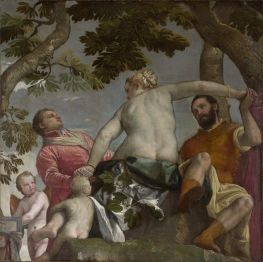
Unfaithfulness c.1575
$3697
$93.61
Paolo Cagliari Veronese
Original Size:190 x 190 cm
National Gallery, London, UK
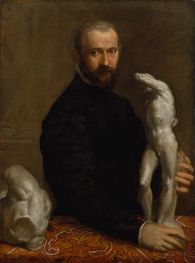
Alessandro Vittoria c.1580
$1472
$69.44
Paolo Cagliari Veronese
Original Size:110.5 x 82 cm
Metropolitan Museum of Art, New York, USA

Boy with a Greyhound 1570s
$1949
$61.76
Paolo Cagliari Veronese
Original Size:173.7 x 102 cm
Metropolitan Museum of Art, New York, USA

